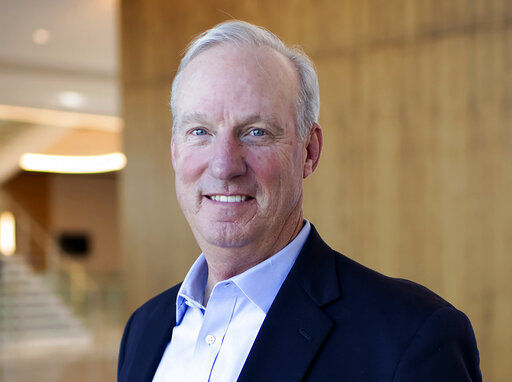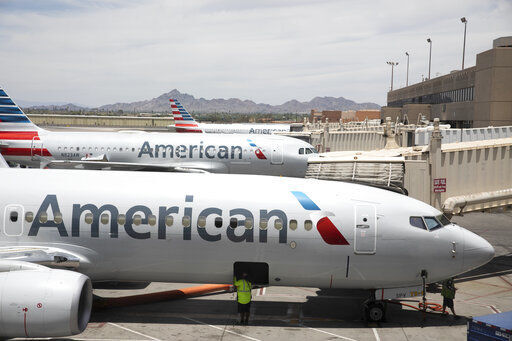FORT WORTH, Texas (AP) — Derek Kerr might have the hardest job in the airline business.
Kerr is the chief financial officer of American Airlines, and his task is to fix a balance sheet that has been battered by borrowing needed to survive the pandemic.
American has the most debt among all U.S. airlines, more than $36 billion. The airline is trying to fly through a bumpy recovery in travel during which revenue is rising but so are costs like fuel and labor.
Kerr spoke recently to The Associated Press. The answers have been edited for length.
Q. American is coming off its first profitable quarter, excluding government aid, since the pandemic started. Planes are packed. What’s going to happen to revenue after Labor Day, when leisure travel slows down?
A. Leisure is really, really strong. Small business is back 100% also, because those businesses had to survive, they are out flying. Corporate business is back about 65%, 75%. As we look out at bookings … we don’t see any huge change from a revenue standpoint as we go forward.
Q. Spot prices for jet fuel prices have eased in the last couple of months, but they’re still double the price before the pandemic. Why doesn’t American hedge against fuel spikes like Southwest does?
A. Hedging is insurance. It’s very expensive, and you can’t insure your entire portfolio of fuel. The airline industry is the No. 2 user of fuel. If we all hedged fuel, we’d move the fuel price and actually drive the fuel price up. Plus you put a risk on the company (if oil prices fall). And then the last thing is you have a natural hedge today — as fuel increases, the industry can raise revenues. We have passed on pretty much the fuel increases that are out there.
Q. American predicts nonfuel costs in the third quarter will be up 12% to 14% compared with the third quarter of 2019 on a per seat, per mile basis. Can you get costs under control?
A. It’s not necessarily a cost issue, it’s a utilization of the fleet issue. If we flew our entire fleet, that (cost per seat per mile) would only be up about 2%. We’ve built these airlines, from a cost perspective, to fly more, and we’re not flying more because of the resources that we need to do that.
Q. How will you fly more? Do you need more pilots?
A. There is a pilot shortage at the (regional airlines) because the mainline carriers (like American, Delta and United) hire from the regionals. We’ll continue to work through that. That may take a couple of years to resolve itself. At the mainline, it’s more about a throughput of training. We can bring the pilots on, we have to get them through training. I hope by the beginning of next year, middle of next year, we’ll work through that and we’ll be able to have the whole mainline fleet up.
Q. When will your profit margins return to pre-pandemic levels?
A. It’s actually the same answer, because obviously that growth will come back at a much cheaper cost because the costs are already here. That will improve the margins over time.
Q. You’ve got $15.6 billion in liquidity. When are you going to use that to pay down debt?
A. Right now we’re going to hold on to that liquidity until we feel like we’ve totally turned the corner. We did have one profitable quarter. That’s awesome, it’s great, I’m proud of everybody here that that worked to get to that point, but we need to sustain that. We are going to take ($15.6 billion of liquidity) down into the $10 (billion) to $12 billion range at some point in time — just not ready to do that yet, but hopefully pretty soon.
Q. Can you refinance your debt with interest rates rising?
A. We’re in really good shape that we don’t have any debt that has come due. We paid off the $750 million unsecured (senior notes that matured in June). Our next big payment is a $1.2 billion term loan (for work at Reagan National and LaGuardia airports) that comes due at the end of next year. The second thing we have to do is finance aircraft. Every aircraft we have is financed through the end of the third quarter. We’re working hard to finance the back half of the year, and there are a lot of good proposals out there, even in a rising interest environment.
Q. Where do you find sources for financing planes?
A. We can do commercial banks. We can do market EETCs (publicly traded securities called enhanced equipment trust certificates). The market for EETCs is open still right now. It’s probably at 100 or 200 basis points bigger than what we have done in the past, but that’s still very attractive financing in this environment.
Q. Is an equity raise on the table?
A. It is not on the table right now. We have enough liquidity to make it through any downturn.
Q. What about share repurchases when the prohibition (a condition of federal pandemic aid) expires Sept. 30?
A. There is no plan to do any share repurchases. All of our excess liquidity will go to pay off debt.
Q. How would a recession change how you manage American’s finances?
A. If it does impact revenues, we would hold on to liquidity longer than than we have. It doesn’t mean that we’re not going to hit our $15 billion number (the target for debt reduction by the end of 2025). It might mean that we don’t accelerate paydown of that debt. But I’m fully confident with the liquidity we have at $15.6 billion that if there is a recessionary environment, that we will be able to withstand anything like that.
Q. American’s stock is being shorted much more often than the shares of Delta, United or Southwest. Why are those investors betting, in effect, that the stock price is going to fall?
A. It doesn’t concern me, but it’s really driven by the balance sheet and the differences between the airlines. We need to continue to make profits. We need to continue to stay on the plan that we’re on, return the airline to profitability, return the reliability of the airline, and everything will take care of itself.
Q. You were the CFO at America West right after 9/11, at US Airways during the airline downturn in the 2008 financial crisis, and at American since late 2013. For the airline business, how does the pandemic compare with those earlier crises?
A. This COVID time has been the hardest of all the times. A recession is one thing, where revenues go down 5% or 10%. When you get to a situation where you have zero receipts and you don’t know when you’re going to get out of this, that was the toughest time.
Q. Could American have survived without the federal aid?
A. American had negative receipts in the month of April 2020. You are refunding more money going out the door than you have coming in. It’s like nothing we’ve ever seen. It would have been really hard for all of us to make it through that.



